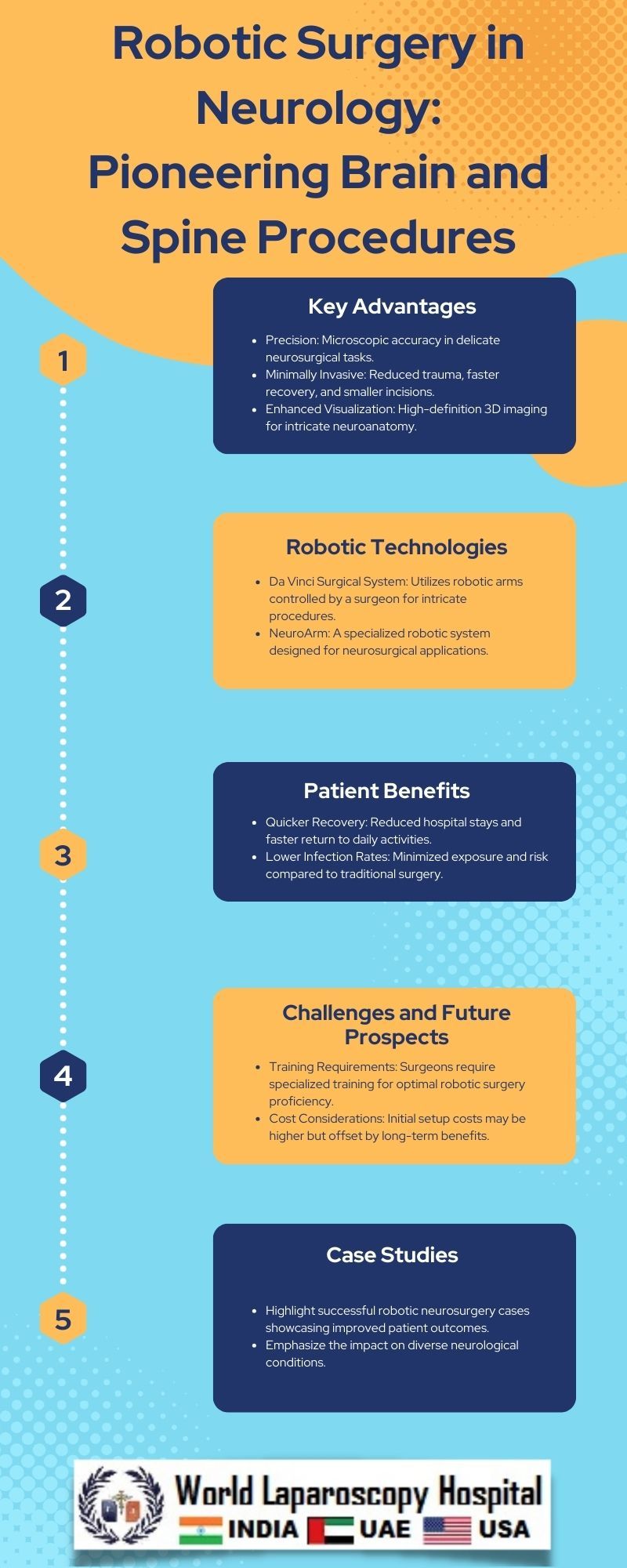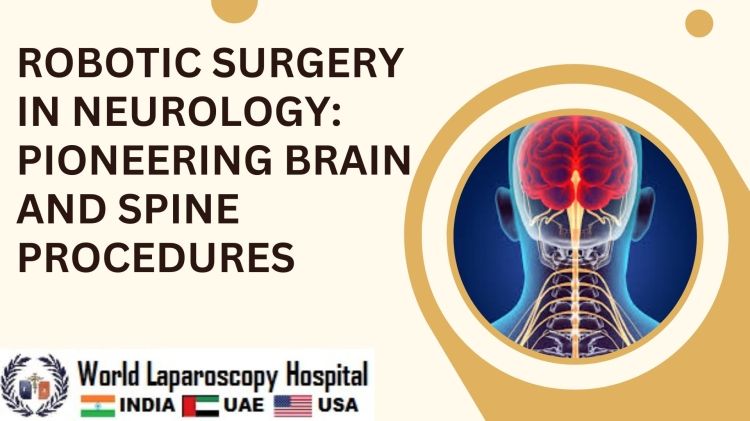Robotic Surgery in Neurology: Pioneering Brain and Spine Procedures
Introduction:
The field of neurosurgery has witnessed a remarkable transformation with the advent of robotic surgery, marking a paradigm shift in the way complex procedures on the brain and spine are performed. As technology continues to advance, robotic systems have emerged as invaluable tools, revolutionizing neurology by enhancing precision, reducing invasiveness, and ultimately improving patient outcomes.

Evolution of Robotic Surgery in Neurology:
Historical Perspective:
The journey of robotic surgery in neurology can be traced back to the late 20th century, with the introduction of early robotic systems like the Puma 560. While these early attempts were rudimentary, they paved the way for more sophisticated technologies, setting the stage for the integration of robotics into neurosurgical procedures.
Technological Advancements:
Over the years, significant technological advancements have propelled robotic surgery in neurology. The development of robotic arms with increased degrees of freedom, enhanced imaging capabilities, and real-time feedback systems has empowered surgeons to navigate the intricate structures of the brain and spine with unprecedented accuracy.
Robotic Systems in Neurosurgery:
Da Vinci Surgical System:
The Da Vinci Surgical System, initially designed for general surgery, has found applications in neurology. With its robotic arms and a console for the surgeon, the Da Vinci system allows for minimally invasive procedures, reducing patient recovery time and postoperative complications. Neurosurgeons utilize this system for tasks ranging from tumor resections to intricate spinal surgeries.
ROSA Robot:
The ROSA robot, short for Robotic Surgical Assistant, specializes in neurosurgery. Equipped with a robotic arm and advanced imaging capabilities, ROSA assists surgeons in planning and executing precise procedures. It has become an invaluable tool in stereotactic brain surgeries, deep brain stimulation, and other delicate interventions.
NeuRobot:
Developed specifically for neurosurgical applications, NeuRobot combines advanced robotics with augmented reality. This system aids surgeons in visualizing critical structures in real time, facilitating meticulous procedures on the brain and spine. NeuRobot exemplifies the fusion of robotics and cutting-edge imaging technologies in the field of neurology.
Applicat Brain Tumor Resection: ions of Robotic Surgery in Neurology:
Brain Tumor Resection:
Robotic surgery has significantly improved the precision and safety of brain tumor resections. Surgeons can now navigate through complex brain structures with enhanced accuracy, minimizing damage to surrounding healthy tissue. The minimally invasive nature of robotic procedures also contributes to faster patient recovery and reduced postoperative complications.
Spinal Surgery:
The spine, with its intricate anatomy, poses unique challenges for surgeons. Robotic systems have revolutionized spinal surgeries by providing real-time imaging, enabling precise placement of implants and facilitating minimally invasive approaches. Conditions such as spinal stenosis, herniated discs, and spinal deformities can be effectively addressed through robotic-assisted procedures.
Deep Brain Stimulation (DBS):
In the realm of neurology, deep brain stimulation has become a crucial therapeutic option for conditions like Parkinson's disease and essential tremor. Robotic systems, such as ROSA, play a pivotal role in enhancing the accuracy of electrode placement during DBS procedures, leading to improved outcomes for patients suffering from movement disorders.
Advantages of Robotic Surgery in Neurology:
Precision and Accuracy:
One of the primary advantages of robotic surgery in neurology is the unparalleled precision and accuracy it offers. Robotic systems allow surgeons to navigate through intricate neural structures with submillimeter precision, reducing the risk of damage to critical areas and improving overall surgical outcomes.
Minimally Invasive Approaches:
Robotic-assisted neurosurgery often involves smaller incisions compared to traditional open surgeries. This minimally invasive approach results in reduced trauma to the surrounding tissues, decreased postoperative pain, shorter hospital stays, and faster recovery for patients.
Real-time Imaging:
Advanced imaging technologies integrated into robotic systems provide real-time visual feedback to surgeons. This capability enhances their ability to visualize critical structures, plan interventions, and make informed decisions during surgery, contributing to safer and more effective procedures.
Enhanced Ergonomics for Surgeons:
Robotic surgery systems are designed with the comfort and ergonomics of surgeons in mind. The robotic consoles offer a more natural and ergonomic interface, reducing the physical strain on surgeons during lengthy procedures. This not only benefits the surgeon's well-being but also contributes to sustained precision throughout the surgery.
Challenges and Future Directions:
Learning Curve:
The adoption of robotic surgery in neurology comes with a learning curve for surgeons. Mastering the interface and techniques specific to each robotic system requires training and experience. As technology evolves, efforts are underway to streamline training programs and ensure widespread proficiency among neurosurgeons.
Cost and Accessibility:
The initial costs associated with acquiring and implementing robotic systems can be substantial. As a result, the accessibility of robotic surgery in neurology may be limited in certain regions or healthcare settings. Ongoing efforts to address these cost barriers and make robotic technology more widely available are crucial for its continued integration into neurosurgical practices.
Integration with Artificial Intelligence:
The future of robotic surgery in neurology is likely to involve deeper integration with artificial intelligence (AI). AI algorithms could assist surgeons in decision-making, preoperative planning, and even autonomous control of certain aspects of the surgery. The synergy between robotics and AI holds the potential to further enhance the precision and efficiency of neurosurgical procedures.
Ethical Considerations and Patient Perspectives:
Informed Consent:
As with any medical innovation, ensuring informed consent is a critical ethical consideration in robotic neurosurgery. Patients must be thoroughly informed about the benefits, risks, and potential outcomes associated with robotic-assisted procedures, allowing them to make informed decisions about their treatment.
Patient Trust and Perception:
Building trust between patients and healthcare providers is essential for the successful adoption of robotic surgery in neurology. Communicating the advantages of robotic systems, addressing concerns, and promoting transparency about the technology's role in enhancing patient care are vital aspects of fostering positive patient perceptions.
Conclusion:
Robotic surgery has emerged as a transformative force in the field of neurology, offering unprecedented precision and safety in brain and spine procedures. The evolution of robotic systems, coupled with ongoing technological advancements, continues to redefine the possibilities in neurosurgery. As the field progresses, addressing challenges, improving accessibility, and maintaining a patient-centric approach will be essential to realizing the full potential of robotic surgery in shaping the future of neurology.
